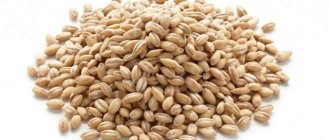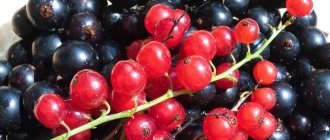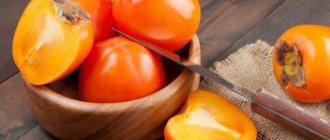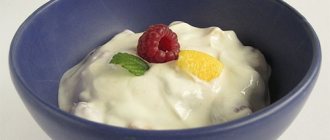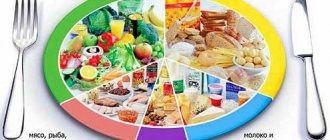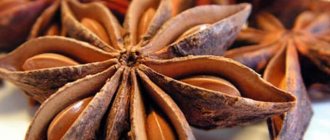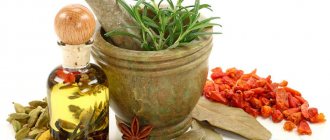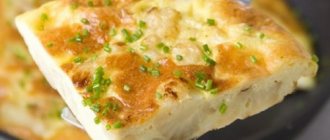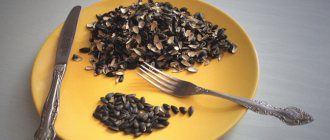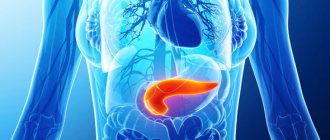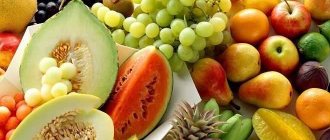The most important condition for a quick recovery in the event of an attack of pancreatitis, along with drug treatment, is adherence to a strict diet. A therapeutic diet involves providing the body with all the substances necessary for normal functioning and protecting the pancreas from chemical, mechanical and temperature damage. Many berries are excluded from the diet of a sick person. Blueberries for pancreatitis are introduced into the diet of a sick person only after the permission of the attending physician and subject to important conditions.
Is it possible to eat jam if you have inflammation of the pancreas?
Jam in small quantities is good for the pancreas.
The product helps improve digestion and metabolism, activates the production of digestive enzymes, and helps strengthen the protective functions of the organ. Due to the presence of tannins in the berries, the delicacy has a wound-healing effect. Blueberry, raspberry, sea buckthorn and currant jam also have a powerful anti-inflammatory and antibacterial effect. The strawberry product helps cleanse the organ of toxins and waste.
In view of these qualities, it is useful for people with healthy digestive organs to consume the deliciousness. Whether it is possible to eat jam with pancreatitis depends on the stage and course of the disease.
In acute cases
The use of jam for acute pancreatitis is strictly prohibited. Despite the fact that it is useful, in particular for the digestive organs, the delicacy:
- It contains a lot of sugars, the processing of which requires a significant amount of insulin and puts a heavy burden on the pancreas, and the inability to cope with the increased need for insulin creates a risk of developing diabetes.
- Saturated with fiber, which, when the digestive organs are damaged, can irritate their mucous membrane, which leads to aggravation of the inflammatory process.
- Contains a significant amount of acids, which provokes increased secretion of pancreatic enzymes and increases the risk of self-destruction of the pancreas from its own secretions.
At the acute stage, jam should also not be added to tea or other dishes.
In chronic form
For chronic pancreatitis, jam can be eaten in small quantities. Consuming such a product will help replenish the body's reserves of vitamins and beneficial elements and will have a beneficial effect on the pancreas.
At the stage of stable remission, the use of such a delicacy helps restore the enzymatic abilities of the pancreas, helps to establish metabolism, digestion, and strengthens the immunity of the gland and the entire body. In addition, jam helps cleanse the body of cholesterol, toxins and waste, which greatly facilitates the functioning of the pancreas. The delicacy takes an active part in tissue regeneration and will help restore areas of the organ damaged by the disease.
You can introduce jam into the diet no earlier than two months after the onset of acute attacks of the disease and no earlier than a month after all symptoms of the disease have subsided.
First, berries without syrup are gradually introduced into the menu, then jam can be added to tea, compotes, and only then, if the body reacts positively, jam can be used in its pure form, as well as added to confectionery, baked goods and casseroles.
What are the benefits of blueberries and blueberries?
Bright blue or light blue berries are a natural source of many healing substances:
- vitamins A, C, E, K, PP, B1,
- tannins, tannins, pectins,
- alkaloids, flavonoids, anthocyanins,
- organic acids,
- vegetable fiber, simple sugars,
- trace elements (potassium, calcium, magnesium, iron, manganese, zinc, chromium, phosphorus).
These compounds in fruits have many beneficial effects on the human body:
- Cleansing the body of waste, toxins, removing metabolic products, heavy metal salts, anti-radiation effects.
- Improved vision.
- Normalization of immunity, increase in tone, the body's defenses to fight viral, bacterial and other infectious diseases.
- Acceleration of metabolism, regeneration of damaged tissues.
- Rejuvenation of the body, prevention of the development of malignant tumors.
- Reducing inflammation, protecting the mucous membranes of the gastrointestinal tract.
- Strengthening the vascular wall, preventing the formation of atherosclerotic plaques in blood vessels.
- Choleretic effect.
- Tannins help eliminate diarrhea.
- Normalization of the secretion of the hormone insulin by the endocrine apparatus of the pancreas.
Rules for using jam for pancreatitis
Eating jam for pancreatitis has some rules:
- Consume no more than one to three teaspoons per day.
- It is allowed to use treats no more than three to four times a week.
- At the beginning of introducing the product into the diet, use jam made from crushed berries.
- Do not eat the treat on an empty stomach.
- Do not use the product late in the evening, especially before bed, so as not to burden the pancreas.
- On the day of consuming jam, it is important to limit the use of other sweets.
- Avoid using treats during periods of exacerbation of the disease.
- The product must be of high quality, without preservatives, stabilizers, dyes and other harmful chemicals.
- You should not eat sour, moldy or fermented jam.
If you follow these recommendations, eating treats will help prolong remission and will not harm your health.
How to use blueberries as a folk remedy?
Blueberries are widely used for the preparation of alternative medicine for the treatment of many diseases of the gastrointestinal tract (pancreatitis, cholecystitis, gastritis). The healing properties of the berry are used to restore damaged organs and normalize their functions. Medicinal teas, infusions, and decoctions are prepared from fresh or dried fruits.
Decoction or infusion of blueberry leaves
This folk remedy is considered useful for a healthy person - for improving immunity, as well as for treating many diseases of the digestive tract, cardiovascular, and endocrine systems.
To prepare the drink you will need crushed blueberry leaves and shoots and a glass of water. Recipe for making an infusion:
- Pour a teaspoon of crushed leaves into a glass of boiling water.
- Close the container with the medicinal product tightly and leave for half an hour.
- Strain the resulting infusion.
It is recommended to take this healing remedy 1 glass three times a day. The course of treatment is usually 1 month.
Allowed and prohibited types of sweets
At the stage of stable remission, you can try almost all types of jam in small quantities. Nutritionists recommend not consuming some varieties at all or with caution, in very small volumes.
What kind of jam can be eaten with pancreatitis, and what it is better to abstain from, will be advised by the doctor in each specific case, taking into account the peculiarities of the course of the disease and the possible presence of accompanying ailments. At the same time, there are general recommendations:
Can be used (safest)
Not recommended for frequent use (you can try it occasionally in small quantities)
Cranberry and dogwood jams are considered the most dangerous for pancreatitis due to their high acid content. Consumption of such a product can lead to irritation of the mucous membranes of the digestive system and the development of an inflammatory process. Therefore, it is better to avoid these types of delicacies altogether.
Possible harm and contraindications for use
Despite the wide range of positive qualities, there are some contraindications to eating blueberries:
- Individual intolerance to the product;
- Increased acidity of gastric juice;
- Cholecystitis - inflammation of the bladder;
- Stones in the kidneys, gall bladder or bile ducts;
- Exacerbation of diseases of the digestive system: erosive damage, ulcers, gastritis, including pancreatitis.
If itching or burning, skin rash, areas of redness, nausea or upset stool, or pain in the abdominal area occur, the berry should be immediately excluded from the diet. Eating too many fresh berries can cause constipation, while dried blueberries, on the contrary, cause diarrhea.
It is especially not recommended to give blueberries to babies under one year of age, as this product can cause a severe allergic reaction. In addition, due to its binding properties, the berry is contraindicated for children suffering from problems such as constipation - it must be discarded until the child’s stool normalizes.
Recipes for healthy homemade jam
In the process of making jam, if possible, it is necessary to get rid of the seeds and skins of the fruit (if the berries allow this). To preserve more vitamins, it is recommended to use the “five-minute” technology, when the product is boiled several times for 5-7 minutes.
“Fresh” jams or berries ground with sugar are very sweet (the amount of sugar in them is twice as high as in the boiled product), so they are allowed to be eaten in a minimal amount - no more than one teaspoon per day.
Raspberry jam
- one kilogram of raspberries;
- half a kilogram of sugar.
Cover the fruits with sugar and set aside for four hours. When the mixture becomes juicy enough, place the container on low heat, bring to a boil and cook for five minutes, stirring constantly. Then set the product aside until it cools.
When the jam has cooled, boil it for another five minutes. Then pour into sterilized jars and seal with a lid.
Blueberry jam
- one kilogram of blueberries;
- one and a half kilograms of sugar.
Cover the fruits with half a portion of sugar and set aside for five hours. After the specified time has passed, drain the juice and add the remaining sugar to it. Bring the syrup to a boil and simmer for 7-10 minutes. Then pour the berries into the syrup, mix well, bring to a boil, and simmer for five minutes. Let the jam cool for a couple of minutes, pour into sterilized jars, and seal with a lid.
Plum jam
It is best to cook this jam in the morning, since after the first boiling it should sit for about eight hours. Components:
- kilogram of plums;
- six glasses of sugar;
- four glasses of water.
Wash the fruits, divide into two slices and remove seeds. Mix water and sugar in a saucepan and place the container on the fire. Bring to a boil, then simmer for another five minutes, stirring constantly with a spoon. Then cover the plums with syrup and set the product aside for four hours.
After the allotted time, the mixture is brought to a boil and boiled for five minutes. Next, remove the container from the heat and let the jam sit for about 8 hours. Then boil for 10-15 minutes and leave again for 8-12 hours. Boil for the last time for 15 minutes. After this, pour into sterilized jars and roll up.
Berry without sugar
- one kilogram of mixed berries (for example, blueberries, currants and strawberries);
- 200 gr. fructose (you can take 1 kg of sorbitol);
- glass of water;
- a pinch of citric acid.
The berries are carefully sorted, washed and after the excess liquid has drained, large strawberries are cut into several parts. At this time, the water is heated, bringing to a boil and mixing with ½ part of the sweetener with citric acid crystals. Next, transfer all the berries into the liquid, turn off the heat and leave to infuse for 6-8 hours (preferably overnight). In this case, it is better to cover the container with a towel so that midges do not get into it and dirt does not get in.
Bring the mixture to a boil and continue cooking for another 15 minutes over low heat. Next, add the remaining fructose and continue cooking for another 10 minutes.
Raspberries in juice
The berries are sorted out of debris and transferred to a jar, shaking it periodically to fit as many raspberries as possible. The container must be filled to the top.
Take a metal basin or deep pan, place a thin towel or cloth napkin on the bottom, and place a jar of berries on it. Next, pour regular water into the basin/pan so that it covers the jar by about 3/4 of the height. The assembled structure is placed on the fire and brought to a boil, after which cooking is continued over low heat. Over time, the berries in the jar will release juices, and the mass will begin to settle, which is why you need to periodically add new portions of berries to it.
Composition and beneficial properties of blueberries
23.01.2018
The most important condition for a quick recovery in the event of an attack of pancreatitis, along with drug treatment, is adherence to a strict diet.
A therapeutic diet involves providing the body with all the substances necessary for normal functioning and protecting the pancreas from chemical, mechanical and temperature damage. Many berries are excluded from the diet of a sick person.
Blueberries for pancreatitis are introduced into the diet of a sick person only after the permission of the attending physician and subject to important conditions.
Bright blue or light blue berries are a natural source of many healing substances:
- vitamins A, C, E, K, PP, B1;
- tannins, tannins, pectins;
- alkaloids, flavonoids, anthocyanins;
- organic acids;
- vegetable fiber, simple sugars;
- trace elements (potassium, calcium, magnesium, iron, manganese, zinc, chromium, phosphorus).
These compounds in fruits have many beneficial effects on the human body:
- Cleansing the body of waste, toxins, removing metabolic products, heavy metal salts, anti-radiation effects.
- Improved vision.
- Normalization of immunity, increase in tone, the body's defenses to fight viral, bacterial and other infectious diseases.
- Acceleration of metabolism, regeneration of damaged tissues.
- Rejuvenation of the body, prevention of the development of malignant tumors.
- Reducing inflammation, protecting the mucous membranes of the gastrointestinal tract.
- Strengthening the vascular wall, preventing the formation of atherosclerotic plaques in blood vessels.
- Choleretic effect.
- Tannins help eliminate diarrhea.
- Normalization of the secretion of the hormone insulin by the endocrine apparatus of the pancreas.
Blueberries are very useful for an inflamed pancreas. This is one of the few berries approved by specialists for pancreatitis. The substances in its composition contribute to the restoration of damaged parenchymal tissue of the pancreas and have a beneficial effect on all metabolic processes in the body. But the consumption of fruits depends on the stage of the disease.
With an exacerbation of the inflammatory process in the pancreas, tissue swelling and cell death in the exocrine and endocrine parts of the organ develop. As a result, many functions of the gland are disrupted.
Eating blueberries during this phase of the disease helps to increase the secretion of digestive juices (gastric, intestinal, pancreatic) due to the irritating effect of the organic acids of the fruit on the mucous membranes of the digestive organs. Due to swelling of the gland and a decrease in the lumen of the efferent ducts, the secretion is not able to leave the organ. Therefore, its enzymes begin to digest their own tissues, causing a dangerous complication of acute pancreatitis - pancreatic necrosis.
After the symptoms of an attack of pancreatitis are relieved, pureed, pureed dishes, soups, and healthy drinks - jelly - are introduced into the diet of a sick person. Kissel can be prepared using fruit or berry purees from the approved list of products. Blueberry jelly can also be drunk if the patient is feeling normal.
When the stage of stable remission is reached and maintained for a long time, the therapeutic diet becomes more varied. Dishes made from fresh or frozen blueberries can replace many harmful sweets that are prohibited for pancreatitis.
These berries can be added to mousses, compotes, jellies prepared using sweeteners instead of regular sugar, especially if diabetes is diagnosed. First, the fruits are consumed in ground, heat-treated form.
The patient can eat whole fresh berries only a few months after the attack, when the symptoms of the disease completely disappear. The attending physician allows you to eat the product if the patient has no complaints of abdominal pain, nausea, vomiting, or diarrhea.
At the stage of stable remission, the daily volume of blueberries should not exceed 3–4 tablespoons per day.
Blueberries have similar properties and composition to blueberries. It is also very beneficial for the pancreas.
Before using blueberries for pancreatitis, you should consult with a specialist (gastroenterologist, nutritionist or therapist) to clarify the phase of the disease and exclude concomitant pathology, which is a contraindication for eating berries.
It is not recommended to eat it if you have cholelithiasis, since blueberries have a pronounced choleretic effect. That is, eating blueberries for cholelithiasis can cause the movement of stones from the gallbladder and blockage of narrow bile ducts with large stones. This condition is the cause of biliary colic and obstructive jaundice.
During an exacerbation of the disease, doctors do not recommend eating blueberries. This will lead to increased abdominal pain, provoke vomiting and diarrhea, which will significantly worsen the patient’s well-being. Uncontrolled consumption of fruits during acute inflammation of the pancreas can cause a serious complication - pancreatic necrosis.
After acute symptoms have been relieved and the disease has entered the remission stage, blueberries can be consumed in the form of jelly, jelly, or added when cooking berry or fruit compote.
You can start eating fresh berries only a year after the exacerbation of the disease. It is recommended to remove the skin from the fruit whenever possible. You can eat no more than 2-3 teaspoons of blueberries per day.
If symptoms of indigestion reappear, the product is again excluded from the diet.
Blueberries are widely used for the preparation of alternative medicine for the treatment of many diseases of the gastrointestinal tract (pancreatitis, cholecystitis, gastritis). The healing properties of the berry are used to restore damaged organs and normalize their functions. Medicinal teas, infusions, and decoctions are prepared from fresh or dried fruits.
This folk remedy is considered useful for a healthy person - for improving immunity, as well as for treating many diseases of the digestive tract, cardiovascular, and endocrine systems.
To prepare the drink you will need crushed blueberry leaves and shoots and a glass of water. Recipe for making an infusion:
- Pour a teaspoon of crushed leaves into a glass of boiling water.
- Close the container with the medicinal product tightly and leave for half an hour.
- Strain the resulting infusion.
It is recommended to take this healing remedy 1 glass three times a day. The course of treatment is usually 1 month.
To prepare this healthy, tasty drink, you will need a tablespoon of berries (fresh or frozen) and a glass of clean water. Cooking steps:
- Place the fruits in a small saucepan and add hot water.
- Place the pan over low heat, bring the water to a boil and simmer for no more than 5 minutes.
- Filter the resulting broth through a sieve and cool to room temperature.
It is recommended to drink this blueberry drink fresh 3 times a day, one glass at a time.
You can also prepare a decoction from both ingredients - the berries and leaves of this plant.
Blueberries and blueberries are extremely healthy, tasty berries, from which a large variety of dishes are prepared, approved for use in many diseases of the digestive system.
For pancreatitis, many experts also recommend eating these berries after reaching the remission phase of the disease. To avoid exacerbation of the disease, it is recommended to prepare dishes from the fruits by chopping and thermally treating the berries.
Traditional medicine specialists also recommend blueberries in the form of a variety of decoctions, infusions and teas.
Blueberries consist of 80% water, 12% carbohydrates, 2.4% dietary fiber, 5.6% proteins and fats. Despite the fact that berries are a low-calorie product, they contain a huge amount of vitamins and biologically active components:
- Vitamins A, B, C, E, K, PP;
- organic acids (malic, citric, ascorbic, oxalic);
- flavonoids;
- tannins;
- anthocyanins;
- polyphenols;
- potassium, manganese, chromium and phosphorus, iron and copper, zinc, selenium and sodium calcium, magnesium.
Not only the fruits, but also the leaves are medicinal. The plant has long been considered a panacea for diseases of the visual organs. Berries activate blood supply and, accordingly, nutrition of the retina. This is very important for maintaining the health and functionality of the entire visual system.
In addition, the plant has the following medicinal properties:
- Anti-inflammatory.
- Antibacterial.
- Disinfectants.
- Antioxidant.
- Diuretic.
- Strengthens the immune system.
- Helps cleanse the body of toxins and salts.
- Improves metabolism and digestion.
- Normalizes stool.
- Reduces the amount of lipids, reducing the risk of developing diabetes.
- Strengthens blood vessels and heart muscle.
- Tones, moisturizes the skin, maintains elasticity.
Blueberries contain a significant amount of anthocyanins, which are natural cancer protectors. Berries also help cleanse the body of free radicals. Therefore, the plant is actively used for the prevention of cancer. The fruits have a pronounced vasodilating effect and are able to lower blood pressure.
The leaves of the plant contain tannins and essential oils and have a pronounced astringent and anti-inflammatory effect. Thanks to this, the use of products with blueberry leaves helps well with disorders of the digestive tract and inflammation.
The dangers of eating sweets
Assimilation of both fresh berries and after boiling them is a big burden on the body. Before deciding whether to allow a deviation from strict dietary therapy, it is recommended to weigh the pros and cons.
A malfunction in the body's functioning when eating sweets is manifested by:
- weakness;
- dizziness;
- flatulence;
- gastralgia;
- stool disorder.
If the instructions of gastroenterologists and nutritionists are ignored, inflammation persists. In addition, the risk of hyperglycemia – primary or secondary diabetes – increases. Experiments are contraindicated for persons suffering from pancreatic disorders.
Important! Following the advice of a nutritionist will speed up your recovery. Self-medication subsequently leads to various serious consequences.
Effective in any situation
The variety of sweet homemade berry dishes is quite large; in turn, our grandparents paid most attention to raspberry jam. The delicacy is useful for colds, sore throats and is essential for the prevention of various diseases. Having knowledge about these beneficial properties of raspberry jam, some patients with pancreatitis decide to test the theory in practice.
We also recommend viewing: PSA level for prostate cancer: diagnostic rules and norms of indicators
In order not to worsen the patient’s condition in the acute form of the disease, raspberry jam should not be consumed, as well as any sweets. While during the transition to the chronic stage you can already afford a teaspoon of sweets.
Basic Rules
Minimalism in sweets is the key to health
The best period when you can eat jam with pancreatitis is remission. However, the gland still remains moderately damaged during this period.
The rules for eating berry dessert must be followed:
- start administration with syrup - 1 tsp. diluted with water;
- if well tolerated, the initial volume can be gradually increased;
- It is preferable to use jam in the form of jam;
- If possible, include homemade preparations in the diet;
- carefully ensure that there are no bones, twigs, or other unpleasant components that have the ability to cause disruptions in the intestines;
- Avoid eating raw or cooked berries on an empty stomach;
- It is optimal to use jam with crackers or biscuits.
Important! To preserve vitamins and microelements, many housewives prefer to prepare jam “five minutes” - with a minimum boiling interval. However, the concentration of berry acids is high.
How to choose
If it is not possible to cook the berries yourself, then the delicacy can be purchased at the store.
In order not to harm your digestion and buy a healthy product, you can remember these little tricks:
- Read the label carefully to see where the dessert was prepared. Fruits and vegetables growing directly in the area where a person lives will bring more benefits to his health.
- Pay close attention to expiration dates - too long ones will indicate the presence of preservatives.
- The jam should be soft in color, transparent and free of foreign inclusions.
- The natural delicacy has a fragrant aroma even through the lid. If the selected jar does not smell, it is better to refuse the purchase.
Jam has been used for a long time to treat colds and other diseases. But when consuming treats, you must follow the rules developed by doctors. Then your health will remain at its best.
Contraindications
Overeating is the main enemy of health
In healthy people, the only limitation is intolerance to any varieties of berries. However, berries are a widely available natural product and the risk of allergy is quite low.
But in the case of inflammation of the pancreas, the list expands:
- Eating all varieties of berries will contribute to a significant increase in the secretion of gastric juices. Therefore, in the first few days of the formation of pancreatic disease, dishes made from them provoke increased gastralgia.
- Due to 20–30% glucose, for every 100 g of jam, the need for insulin increases. This also negatively affects the course of the disease.
- Another obvious limitation for the preparation, purchase and consumption of canned assorted berries is diabetes. Its appearance is due to the inability to fully process glucose coming from outside.
During the period when inflammatory symptoms subside, it is not the jam itself that acts as a provoking factor, but its quantity.
Important! It is not recommended to eat a lot of jam at once - it is better to savor it a little at a time. This will prolong the pleasure and will not provoke a new attack of exacerbation of the disease.
Is it possible to eat blueberries if you are sick?
The term “pancreatitis” in medicine refers to inflammation of the pancreas, an organ of the digestive system responsible not only for the production of individual hormones, but also for the production of enzymes. The role of this secretion is very important for the normal functioning of the human body. Released by the pancreas, they enter the duodenum, where they begin active digestion of food. As a result of its breakdown, the most important components necessary for full human health are formed and subsequently absorbed by the body.
When a person begins to abuse alcohol, fatty foods and other unhealthy foods, serious changes occur in his pancreas: intoxication of the body leads to the fact that the tissues of the organ are sooner or later damaged, and therefore the outflow of its secretions is disrupted, and the pancreas itself swells greatly . Many people know that pancreatitis is dangerous not only for its symptoms: severe abdominal pain, vomiting and diarrhea, but also for its high risk of death. And there is an explanation for this. Enzymes that are constantly secreted by the pancreas lose the ability to be freely transported to the small intestine. As they accumulate, they not only begin to corrode the pancreas itself, but also seek further exit, penetrating into nearby blood vessels.
In order to somewhat curb this aggressive process, the patient is given a strict diet, and in the first days of the crisis he is generally forced to starve. In the future, any food that can lead to a load on the pancreas is excluded from his diet, and the emphasis is on easily digestible foods that are at the same time rich in vitamins and nutrients.
Fearing harm to their health, patients with pancreatitis are selective about food, so very often doctors hear from them questions about whether they can consume this or that product. People treat berries with special caution, because not all of them can be eaten if you have this disease. A special place in this topic is given to blueberries, since they are an exception to this rule.
Blueberries are especially beneficial for the digestive system. By improving metabolism, it has a strong anti-inflammatory and antibacterial effect. During an exacerbation of pancreatitis, it is very important to relieve inflammation so that enzymes can freely reach their destination. Thus, they stop damaging the pancreas, and the disease begins to gradually recede. This is precisely what contributes to the consumption of blueberries or decoctions of its leaves.
Since inflammation of the pancreas is accompanied by impaired digestion, some food remains undigested, and therefore rotting processes begin in the intestines: pathogenic microorganisms multiply, thereby causing dysbiosis and other undesirable phenomena. Blueberries, having a disinfectant effect, gradually normalize the existing microflora and bring the patient’s condition in order.
Experts allow the use of not only the fruits, but also their leaves for medicinal purposes. This vegetation has an astringent effect, due to which the permeability of the surface of the pancreas is significantly reduced and a special film is formed that protects the organ from external irritants. In addition, another positive property that the leaves characterize is their ability to reduce the activity of pancreatic fermentation, which is very useful for an inflamed organ.
That is why, answering the question whether it is allowed to use blueberries and decoctions from them for pancreatitis, we can say with confidence - definitely yes. However, there are also some nuances here, which we will talk about a little later. Now let’s try to figure out exactly why the berry is useful and what contribution it can make to the patient’s recovery process.
